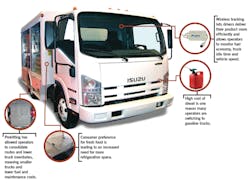Customization: Adjusting Vehicles To Fit Changing Needs
It is common knowledge that vehicles are not typically an “investment”. Commuter vehicles get consumers from Point A to Point B and generally depreciate in value with every mile driven. In an industry where goods and services are transported via delivery vehicle, however, trucks and vans are just as important as warehouse space; nowadays, operators are beginning to view the vehicle as a more specialized investment.
In the past, vending operators could use box trucks to deliver product from the warehouse to a location. Now, prekitting and refrigeration needs are causing vending operators to see vehicles as an integral investment in their business and more importantly, as a customized tool of transit.
Vehicles as tools
Vehicles aren’t just a means of transportation anymore, says Trak Coveleskie, director of sales and marketing for Equipment Innovators. “Operators have traditionally thought of trucks as a place to put things for transport. Now, I think, they use them as a tool to help do their job better and faster,” he said. More operators are catering to increased prekitting, micro market installation and refrigeration needs by customizing their fleet. And Coveleskie is not alone in his belief.
“Vending trucks are becoming more specialized,” said Jeff Maloof, director of fleet development for Isuzu Commercial Truck of America. “In the past, it was acceptable for a full-line vending operator to use a standard box truck or cube van. Today, more operators understand that if you want high weekly route revenue, you have to have a truck specifically designed for the job.”
With customized trucks, operators have the option of adding features such as body refrigeration and moveable shelves that will make their routes more efficient. More importantly, however, vehicles can be customized to carry a more diverse offering such as micro market or OCS product should an operator wish to expand certain services.
However, tailoring a vehicle’s interior isn’t cheap, says Richard Ball, director of marketing and business development at VT Hackney. “Any customization to a truck costs money,” said Ball. Instead of telling manufacturers how to build the body, Ball recommends that operators approach manufacturers with a business plan of present and future needs. There is a better return on investment if the truck is designed for long-term business growth, which can save an operator a lot of money in the long run, Ball believes. “There is still that question mark in the industry of how to put it (vehicle design) all together into one package from the front end all the way to the back end that is not only efficient but the least cost of capital up front,” Ball added.
Technology means efficiency
Largely adopted in the last decade, prekitting has allowed operators to consolidate routes and lower truck inventories, meaning smaller trucks and lower fuel and maintenance costs. “Prekit delivery has proven to significantly increase the amount of revenue a route salesperson handles each week as well,” said Maloof. “The bonus is that prekit trucks will generally need less payload and can be less expensive to operate; however, I would warn operators against buying trucks that are too small. Operators need to make sure their trucks can legally carry their route driver’s load and have room for growth.” The prekitting trend not only increases route driver revenue, but it also provides an opportunity for operators to view their current fleet and make possible changes. “Whether it’s full-line vending, office coffee service or tire delivery, we are seeing our customers use technology to load their delivery trucks more effectively,” added Maloof.
Prekitting, however, is not the only technology trend when it comes to transportation. Maloof reports a growing number of operators combining wireless tracking into their transportation requests. “We are seeing the majority of our delivery customers move to wireless vehicle tracking,” he said. “Vehicle tracking systems are powerful and now they are inexpensive. For example, for about $40 a month per truck you can monitor fuel economy, truck idle time, vehicle speed and so forth. Additionally, if a route salesperson goes outside or their route path or they exceed the speed limit, it sends their supervisor a text.”
Increased need for refrigeration
One issue that operators are facing is an increased need for refrigeration, which is brought on largely by micro markets and consumer demand for fresh food. “There is a lot more frozen and fresh food on trucks than in years past,” said Coveleskie. “And food regulations, including food temperatures, are front and center with vending operators.” Not only are operators tasked with providing more fresh food, but they also have to offer traditional vending snacks such as candy and pastries that can melt in the truck body if it gets too hot. This increased need for refrigeration can cost a driver time and money if they have to access the refrigerator at each stop. Ball added, “Some operators ask us if we can just refrigerate the whole truck instead of offering a traditional cooler. The drawback is the high level of displacement due to the increased number of stops and door openings on a vending route. As refrigeration demand grows, more insulation and larger mechanical units will be needed, so balancing costs and efficiency is important.”
The solution for some operators is to keep the body of the truck at an ambient temperature, between 60 and 70 degrees Fahrenheit. Some manufacturers are even offering a moveable bulkhead that gives the operator the opportunity to decide how much space he or she wants to refrigerate.
“There are a lot of juices that have to stay cold throughout the entire process,” said Ball. “So vending companies are still trying to figure out how to best get a product from their location into the locations’ hands from the delivery standpoint. But price is the largest issue for operators when making an investment in a vehicle; you can easily increase the cost of a truck by $10,000 by adding refrigeration.”
There is no doubt that vehicles are becoming a more prominent investment for vending operators. The right type of vehicle should last an operator for both present and future needs, therefore, manufacturers tell operators to think ahead to where their companies will be in five to ten years. Will their vending company increase micro market offerings? Perhaps the company will move strictly to office coffee? There is no predicting the future, but the age of the rolling warehouse is over and customization is quickly taking the lead.
Ye Be Warned
Although the number of ways to save money in the industry is dwindling, operators need to remember that cutting corners when it comes to transportation is never a good idea. “I’ve seen operators attempt to save money on fuel and purchase trucks that are too small for the job,” said Jeff Maloof. “Very seldom does this strategy work. Many times these smaller trucks fail in 3 to 4 years and the maintenance cost for brakes and tires goes through the roof.”
“I’ve even seen some operators use dry ice to meet refrigeration needs,” added Trak Coveleskie. “This is very dangerous.”
The move to gasoline
Although nearly all operators in the past have used diesel, vehicles that run on gasoline are becoming more popular. “Diesel trucks are not as reliable as they used to be and the new pollution controls on diesel engines have been a challenge for all manufacturers,” said Jeff Maloof. “This issue has encouraged some operators to move to gasoline engines.”
Which truck would you recommend?
"Isuzu's NPR-HD gas truck has become very popular with full-line vending and micro market routes," said Maloof. "With most of these routes under 25,000 miles per year, the gas powered truck make sense. For the longer distance routes, our Ecomax diesel truck has sold very well. It has a small diesel engine and achieves surprising MPGs."
"The PreKit Omnivan, of course!" said Coveleskie. "It can feature three different temperature zones--frozen, fresh and cooled--up to 80 prekit boxes, and 80 cases of soda."
"It all depends on the customer's business needs," said Ball. "But I would recommend VT Hackney's Express model for those operators going into micro markets and prekitting. This model offers various cooler options, as well as adjustable shelving and drop step ergonomic design for high and low retrieval heights."
About the Author

Adrienne Klein
Contributing Editor
Adrienne Zimmer Klein is a freelance writer with a background in the vending, micro market and office coffee service industry. She worked as an associate editor and managing editor at Automatic Merchandiser and VendingMarketWatch.com from 2013 until 2017. She is a regular contributing writer at Automatic Merchandiser.
